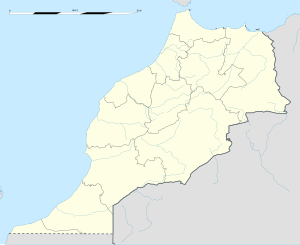Tinghir
|
Tinghir ⵜⵉⵏⵖⵉⵔ Toudgha |
|
|---|---|
| Tineghir transcription(s) | |
 |
|
| Nickname(s): tdghot | |
| Location in Morocco | |
| Coordinates: 31°30′53″N 5°31′58″W / 31.51472°N 5.53278°WCoordinates: 31°30′53″N 5°31′58″W / 31.51472°N 5.53278°W | |
| Country |
|
| Region | Drâa-Tafilalet |
| Province | Tinghir |
| Population (2014) | |
| • Total | 42,044 |
| Time zone | WET (UTC+0) |
| • Summer (DST) | WEST (UTC+1) |
Tinghir or Tinerhir (Arabic: تنغير, Tamazight: ⵜⵉⵏⵖⵉⵔ) is a city in the region of Drâa-Tafilalet, south of the High Atlas and north of the Little Atlas in southeastern Morocco. It is the capital of Tinghir Province. Its name originally referred to the foothills of the Atlas Mountains, but its area has expanded to encompass surrounding villages and refers to the entire oasis.
The city of Tinghir (Baladia tinghir) has a population of 42 044 and the province has 322 412 inhabitants, according to the 2014 census. The predominant ethnic group is Amazighs, and the city is at the center of one of the most attractive oases in southern Morocco. Lush palm trees cover about 30 miles (48 km) on 500-to-1,500-metre (550 to 1,640 yd)-wide tracts along the Wadi Todgha. After the Todra Gorge, Wadi Todgha has a difficult passage along the southern slopes of the Atlas Mountains (Tizgui); it then flows across the plain, meandering slightly over 20 kilometres (12 mi) to Ferkla. The palm oasis, dense and widespread, is irrigated by a network of pipes and irrigation canals. Occasional heavy rains are absorbed in a few days.
The economy of Tinghir is based on agriculture, trade and tourism. In addition, many families live on money sent home by relatives working in Europe. Social and cultural activities are increasing; education projects for young children are increasing in many villages, as well as literacy projects aimed at adults (particularly women). These projects are supported by local and nongovernmental organisations.
Tinghir is an oasis about 30 kilometres (19 mi) long and about 4 kilometres (2.5 mi) wide. The climate is arid subtropical: hot, dry winters in relation to altitude (1,430 metres (4,690 ft)). There are a few rainy days per year, with the greatest precipitation in fall and winter.
...
Wikipedia

